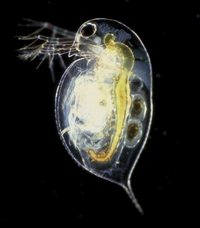
Photo from wikipedia
Species with large geographic distributions present a challenge for phylogeographic studies due to the logistic difficulties of obtaining adequate samples. Daphnia O.F. Müller (Anomopoda: Daphniidae) is a model genus for… Click to show full abstract
Species with large geographic distributions present a challenge for phylogeographic studies due to the logistic difficulties of obtaining adequate samples. Daphnia O.F. Müller (Anomopoda: Daphniidae) is a model genus for evolutionary biology and ecology, but many regions such as the remote areas of Siberia, remain poorly studied. Here we examined genetic polymorphism in the ribosomal 12S and the protein-coding ND2 mitochondrial genes of three closely related taxa of the Daphnia (Daphnia) longispina complex, namely D. galeata Sars, D. longispina O.F. Müller and D. dentifera Forbes. We estimated the phylogenetic relationships among these taxa based on a concatenated alignment of these two genes. Using sequences from the present study and those available in GenBank, we investigated the geographic distributions of the mitochondrial haplotypes of these species and proposed an evolutionary scenario for each taxon. Network structures, haplotype distribution patterns, and FST values indicated significant differences in the evolutionary history of the examined species. Our analysis of D. galeata populations confirmed its recent and fast expansion, without a previous phase of a strong population disconnection. In contrast, the high haplotype diversity in D. dentifera and D. longispina could be explained by the survival of different phylogroups in several glacial refugia located in different geographic regions. For all studied species, maximum haplotype diversity was recorded in the remote regions of Siberia–lakes of the Yenisei River and Transbaikalia. Our study is an important step in our understanding of the evolutionary history of the Daphnia longispina group and provides further evidence of the biogeographic significance of Siberia for freshwater taxa.
Journal Title: PLoS ONE
Year Published: 2018
Link to full text (if available)
Share on Social Media: Sign Up to like & get
recommendations!